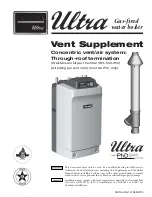
7
Tightness test
After installation, flue systems routed
through a shaft must be tested for tight-
ness by the flue gas inspector [check
local regulations].
■ Pressurised flues which are routed
inside buildings and which are not
surrounded by combustion air
(
open
flue) must be pressure-tested.
For the pressure test, a leak detector
is used to pump air into the flue,
which has been sealed at the top and
bottom, until a pressure of
200 Pa
has built. This pressure is maintained
while the volume of air leaking out is
established.
A leakage rate of up to
0.006 l/(s x m
2
), relative to the inter-
nal surface area, is permitted for
classifying a flue as sufficiently gas-
tight.
■ In pressurised flues that are surroun-
ded by combustion air (room sealed),
the tightness can be checked by test-
ing the O
2
content in the combustion
air (annular gap test).
The flue is considered sufficiently
gas-tight if the O
2
content in the com-
bustion air does not deviate from the
reference value by more than the fol-
lowing values. The reference value is
established following the self-adjust-
ment of the test meter:
– For flues with general Building
Regulations approval 0.4 % by vol.
– For other flues 0.2 % by vol.
Note
Observe country-specific regulations.
Certification of the balanced flue system
The balanced flue system is CE desig-
nated and approved in accordance with
EN 14471 (see flue systems technical
guide).
General installation information
(cont.)
5780 223 GB
Summary of Contents for Vitocaldens 222-F
Page 58: ...58 5780 223 GB ...
Page 59: ...59 5780 223 GB ...








































